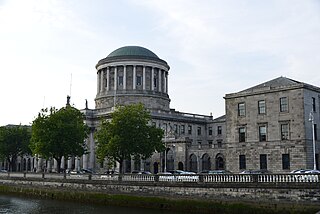
The United States courts of appeals are the intermediate appellate courts of the United States federal judiciary. They hear appeals of cases from the United States district courts and some U.S. administrative agencies, and their decisions can be appealed to the Supreme Court of the United States. The courts of appeals are divided into 13 "Circuits". Eleven of the circuits are numbered "First" through "Eleventh" and cover geographic areas of the United States and hear appeals from the U.S. district courts within their borders. The District of Columbia Circuit covers only Washington, DC. The Federal Circuit hears appeals from federal courts across the United States in cases involving certain specialized areas of law.
Oliphant v. Suquamish Indian Tribe, 435 U.S. 191 (1978), is a United States Supreme Court case deciding that Indian tribal courts have no criminal jurisdiction over non-Indians. The case was decided on March 6, 1978 with a 6–2 majority. The court opinion was written by William Rehnquist, and a dissenting opinion was written by Thurgood Marshall, who was joined by Chief Justice Warren Burger. Justice William J. Brennan did not participate in the decision.
Buck v. Bell, 274 U.S. 200 (1927), is a decision of the United States Supreme Court, written by Justice Oliver Wendell Holmes Jr., in which the Court ruled that a state statute permitting compulsory sterilization of the unfit, including the intellectually disabled, "for the protection and health of the state" did not violate the Due Process Clause of the Fourteenth Amendment to the United States Constitution. Despite the changing attitudes in the coming decades regarding sterilization, the Supreme Court has never expressly overturned Buck v. Bell. It is widely believed to have been weakened by Skinner v. Oklahoma, 316 U.S. 535 (1942), which involved compulsory sterilization of male habitual criminals. Legal scholar and Holmes biographer G. Edward White, in fact, wrote, "the Supreme Court has distinguished the case [Buck v. Bell] out of existence". In addition, federal statutes, including the Rehabilitation Act of 1973 and the Americans with Disabilities Act of 1990, provide protections for people with disabilities, defined as both physical and mental impairments.

The Supreme Court of Ireland is the highest judicial authority in Ireland. It is a court of final appeal and exercises, in conjunction with the Court of Appeal and the High Court, judicial review over Acts of the Oireachtas. The Supreme Court also has appellate jurisdiction to ensure compliance with the Constitution of Ireland by governmental bodies and private citizens. It sits in the Four Courts in Dublin.
Skinner v. State of Oklahoma, ex rel. Williamson, 316 U.S. 535 (1942), is a unanimous United States Supreme Court ruling that held that laws permitting the compulsory sterilization of criminals are unconstitutional as it violates a person's rights given under the 14th Amendment of the United States Constitution, specifically the Equal Protection Clause and the Due Process Clause. The relevant Oklahoma law applied to "habitual criminals" but excluded white-collar crimes from carrying sterilization penalties.

The Supreme Court of Virginia is the highest court in the Commonwealth of Virginia. It primarily hears direct appeals in civil cases from the trial-level city and county circuit courts, as well as the criminal law, family law and administrative law cases that are initially appealed to the Court of Appeals of Virginia. Established in 1779 as the Supreme Court of Appeals, the Supreme Court of Virginia is one of the oldest continuously active judicial bodies in the United States.

The Indiana Supreme Court, established by Article 7 of the Indiana Constitution, is the highest judicial authority in the state of Indiana. Located in Indianapolis, the Court's chambers are in the north wing of the Indiana Statehouse.
Jesse Ernest Eschbach was a United States district judge of the United States District Court for the Northern District of Indiana and a United States Circuit Judge of the United States Court of Appeals for the Seventh Circuit.
A court of general jurisdiction, in the law of the United States, is a court with authority to hear cases in law and in equity of all kinds – criminal, civil, family, probate, and other legal claims.
Judicial immunity is a form of sovereign immunity, which protects judges and others employed by the judiciary from liability resulting from their judicial actions. It is intended to ensure that judges can make decisions free from improper influence exercised on them, contributing to the impartiality of the judiciary and the rule of law. In modern times, the main purpose of "judicial immunity [is to shield] judges from the suits of ordinary people", primarily litigants who may be dissatisfied with the outcome of a case decided by the judge.
Harlington Wood Jr. was an American lawyer, jurist, political figure and an amateur actor. He served as a United States circuit judge of the United States Court of Appeals for the Seventh Circuit from 1976 until his death in 2008, after earlier serving as a United States district judge of the United States District Court for the Southern District of Illinois. He was considered one of the country's leading legal historians on the life and legacy of former lawyer and United States President Abraham Lincoln, but is perhaps best known for his involvement as an Assistant Attorney General for the United States Department of Justice in two separate Native American armed protests: the first being the occupation at Alcatraz Island, in San Francisco Bay, from 1969 through the summer of 1971, and the second being the Wounded Knee incident in 1973 at Wounded Knee, South Dakota. His accomplishments and impact as both jurist and statesman included participation in many recent events around the world, which he circled three times, including Russia, Outer Mongolia, Europe, Cambodia, Greenland, China, Japan and South America.
In United States law, absolute immunity is a type of sovereign immunity for government officials that confers complete immunity from criminal prosecution and suits for damages, so long as officials are acting within the scope of their duties. The Supreme Court of the United States has consistently held that government officials deserve some type of immunity from lawsuits for damages, and that the common law recognized this immunity. The Court reasons that this immunity is necessary to protect public officials from excessive interference with their responsibilities and from "potentially disabling threats of liability."

The Supreme Court of Mississippi is the highest court in the state of Mississippi. It was established in 1818 per the terms of the first constitution of the state and was known as the High Court of Errors and Appeals from 1832 to 1869. The court is an appellate court. The court consists of nine justices elected in nonpartisan contests from three districts to serve eight-year terms. The most senior justice serves as the chief justice. It is housed in the Carroll Gartin Justice Building in Jackson, Mississippi, the state capital.
The Star is an American daily newspaper published in Auburn, Indiana. It is owned by KPC Media Group.
Daimler AG v. Bauman, 571 U.S. 117 (2014), is a United States Supreme Court case in which the Court answered whether an American court may exercise jurisdiction over a foreign company based on the fact that a subsidiary of the company acts on its behalf in the jurisdictional state. The court held that an American company cannot be sued for conduct occurring outside the United States and American courts do not have jurisdiction of such a claim.
Sterilization law is the area of law, within reproductive rights, that gives a person the right to choose or refuse reproductive sterilization and governs when the government may limit this fundamental right. Sterilization law includes federal and state constitutional law, statutory law, administrative law, and common law. This article primarily focuses on laws concerning compulsory sterilization that have not been repealed or abrogated and are still good laws, in whole or in part, in each jurisdiction.
Bank Markazi v. Peterson, 578 U.S. 212 (2016), was a United States Supreme Court case that found that a law which only applied to a specific case, identified by docket number, and eliminated all of the defenses one party had raised does not violate the separation of powers in the United States Constitution between the legislative (Congress) and judicial branches of government. The plaintiffs, in the case had initially obtained judgments against Iran for its role in supporting state-sponsored terrorism, particularly the 1983 Beirut barracks bombings and 1996 Khobar Towers bombing, and sought execution against a bank account in New York held, through European intermediaries, on behalf of Bank Markazi, the Central Bank of the Islamic Republic of Iran. The plaintiffs obtained court orders preventing the transfer of funds from the account in 2008 and initiated their lawsuit in 2010. Bank Markazi raised several defenses, including that the account was not an asset of the bank, but rather an asset of its European intermediary, under both New York state property law and §201(a) of the Terrorism Risk Insurance Act. In response to concerns that existing laws were insufficient for the account to be used to settle the judgments, Congress added an amendment to a 2012 bill, codified after enactment as 22 U.S.C. § 8772, that identified the pending lawsuit by docket number, applied only to the assets in the identified case, and effectively abrogated every legal basis available to Bank Markazi to prevent the plaintiffs from executing their claims against the account. Bank Markazi then argued that § 8772 was an unconstitutional breach of the separation of power between the legislative and judicial branches of government, because it effectively directed a particular result in a single case without changing the generally applicable law. The United States District Court for the Southern District of New York and, on appeal, the United States Court of Appeals for the Second Circuit both upheld the constitutionality of § 8772 and cleared the way for the plaintiffs to execute their judgments against the account, which held about $1.75 billion in cash.

Amy Vivian Coney Barrett is an American lawyer and jurist who serves as an associate justice of the Supreme Court of the United States. The fifth woman to serve on the court, she was nominated by President Donald Trump and has served since October 27, 2020. Barrett was a U.S. circuit judge on the U.S. Court of Appeals for the Seventh Circuit from 2017 to 2020.
Franchise Tax Board of California v. Hyatt, 587 U.S. ___ (2019), was a United States Supreme Court case that determined that unless they consent, states have sovereign immunity from private suits filed against them in the courts of another state. The 5–4 decision overturned precedent set in a 1979 Supreme Court case, Nevada v. Hall. This was the third time that the litigants had presented their case to the Court, as the Court had already ruled on the issue in 2003 and 2016.







